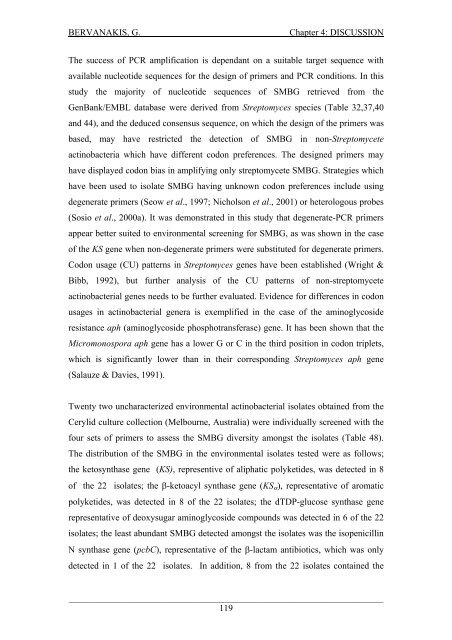Detection and Expression of Biosynthetic Genes in Actinobacteria ...
Detection and Expression of Biosynthetic Genes in Actinobacteria ...
Detection and Expression of Biosynthetic Genes in Actinobacteria ...
You also want an ePaper? Increase the reach of your titles
YUMPU automatically turns print PDFs into web optimized ePapers that Google loves.
BERVANAKIS, G.Chapter 4: DISCUSSIONThe success <strong>of</strong> PCR amplification is dependant on a suitable target sequence withavailable nucleotide sequences for the design <strong>of</strong> primers <strong>and</strong> PCR conditions. In thisstudy the majority <strong>of</strong> nucleotide sequences <strong>of</strong> SMBG retrieved from theGenBank/EMBL database were derived from Streptomyces species (Table 32,37,40<strong>and</strong> 44), <strong>and</strong> the deduced consensus sequence, on which the design <strong>of</strong> the primers wasbased, may have restricted the detection <strong>of</strong> SMBG <strong>in</strong> non-Streptomyceteact<strong>in</strong>obacteria which have different codon preferences. The designed primers mayhave displayed codon bias <strong>in</strong> amplify<strong>in</strong>g only streptomycete SMBG. Strategies whichhave been used to isolate SMBG hav<strong>in</strong>g unknown codon preferences <strong>in</strong>clude us<strong>in</strong>gdegenerate primers (Seow et al., 1997; Nicholson et al., 2001) or heterologous probes(Sosio et al., 2000a). It was demonstrated <strong>in</strong> this study that degenerate-PCR primersappear better suited to environmental screen<strong>in</strong>g for SMBG, as was shown <strong>in</strong> the case<strong>of</strong> the KS gene when non-degenerate primers were substituted for degenerate primers.Codon usage (CU) patterns <strong>in</strong> Streptomyces genes have been established (Wright &Bibb, 1992), but further analysis <strong>of</strong> the CU patterns <strong>of</strong> non-streptomyceteact<strong>in</strong>obacterial genes needs to be further evaluated. Evidence for differences <strong>in</strong> codonusages <strong>in</strong> act<strong>in</strong>obacterial genera is exemplified <strong>in</strong> the case <strong>of</strong> the am<strong>in</strong>oglycosideresistance aph (am<strong>in</strong>oglycoside phosphotransferase) gene. It has been shown that theMicromonospora aph gene has a lower G or C <strong>in</strong> the third position <strong>in</strong> codon triplets,which is significantly lower than <strong>in</strong> their correspond<strong>in</strong>g Streptomyces aph gene(Salauze & Davies, 1991).Twenty two uncharacterized environmental act<strong>in</strong>obacterial isolates obta<strong>in</strong>ed from theCerylid culture collection (Melbourne, Australia) were <strong>in</strong>dividually screened with thefour sets <strong>of</strong> primers to assess the SMBG diversity amongst the isolates (Table 48).The distribution <strong>of</strong> the SMBG <strong>in</strong> the environmental isolates tested were as follows;the ketosynthase gene (KS), representive <strong>of</strong> aliphatic polyketides, was detected <strong>in</strong> 8<strong>of</strong> the 22 isolates; the β-ketoacyl synthase gene (KS α ), representative <strong>of</strong> aromaticpolyketides, was detected <strong>in</strong> 8 <strong>of</strong> the 22 isolates; the dTDP-glucose synthase generepresentative <strong>of</strong> deoxysugar am<strong>in</strong>oglycoside compounds was detected <strong>in</strong> 6 <strong>of</strong> the 22isolates; the least abundant SMBG detected amongst the isolates was the isopenicill<strong>in</strong>N synthase gene (pcbC), representative <strong>of</strong> the β-lactam antibiotics, which was onlydetected <strong>in</strong> 1 <strong>of</strong> the 22 isolates. In addition, 8 from the 22 isolates conta<strong>in</strong>ed the_____________________________________________________________________119















